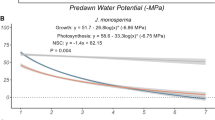Summary
Increases in plant biomass are mainly a balance between growth of new leaves and growth of new roots, the new leaves having positive feedback upon the production process and the new roots having positive feedback upon the plant water status. Control of both opposing processes with respect to biomass production may be considered optimal whenever biomass of the plant reaches a maximum without adversely affecting plant water status. This occurs only if all carbohydrates are partitioned into growth of new leaves, unless water uptake is insufficient to meet the additional evaporative demand created by the newly grown leaf area without decreasing the water status of the plant. It is shown by theoretical considerations based upon optimization theory, especially by application of the Pontryagin Maximum Principle, that in this case carbohydrate partitioning is dependent upon the transpiration rate per leaf weight and upon the efficiency of the root at taking up water. Growth of Vigna unguiculata at two levels of air humidity and two levels of water uptake rate by the root was consistent with such a carbohydrate partitioning pattern. Growth of total biomass and its components (leaves, stems, and roots), whole plant transpiration, and the pattern of carbon partitioning were predicted and explained by applying the foregoing principles of optimization in a heuristic model for vegetative growth of an annual.
Similar content being viewed by others
References
Brouwer R (1981) Co-ordination of growth phenomena within a root system of intact maize plants. In: Brouwer R (ed) Structure and function of plant roots. Dr. W Junk Publishers. The Hague, Boston, London pp 269–276
Brouwer R, DeWit CT (1968) A simulation model of plant growth with special attention to root growth and its consequences. In: Whittington WJ (ed) Root Growth, Butterworths, London
Cowan IR, Farquhar GD (1977) Stomatal function in relation to leaf metabolism and environment. In: Jennings DH (ed) Integration of activity in the higher plant. Cambridge, at the University Press pp 471–505
Eavis BW, Taylor HM (1979) Transpiration of soybeans as related to leaf area, root length and soil water content. Agronomy Journal 7:442–445
Farquhar GD, Schulze E-D, Küppers M (1980) Responses to humidity by stomata of Nicotiana glauca L. and Corylus avellana L. are consistent with the optimization of carbon dioxide uptake with respect to water loss. Aust J Plant Physiol 7:315–327
Hackett C, Rawson HM (1974) Photosynthesis and the carbon economy of a dicotyledonous plant (Nicotiana tabacum L.): Results from simulation and experiment. The Royal Society of New Zealand, Bulletin 12:269–276
Hall AE, Foster KW, Waines JG (1979) Crop adaptation to semiarid environments. In: Hall AE, Cannell GH, Lawton HW (eds) Agriculture in semi-arid environments. Ecol Studies Vol 34, Springer, Berlin Heidelberg New York pp 148–179
Hall AE, Schulze E-D (1980) Stomatal response to environment and a possible interrelation between stomatal effects on transpiration and CO2 assimilation. Plant Cell and Environment 3:467–474
Hesketh JD, Mistoe JW, Jones JW, Brown LG (1981) Plant growth regulators and crop modelling. Proc Am Soc Plant Growth Regulators
Maurer H (1976) Optimale Steuerprozesse mit Zustandsbeschränkungen, Habilitationsschrift, Würzburg
Maurer H (1977) On optimal control problems with bounded state variables and control appearing linearly. SIAM J Control and Optimization 15:345–362
Nagarajah S, Schulze E-D (1982) Responses of Vigna unguiculata L Walp to atmospheric and soil drought. Aust J Plant Physiol (in press)
Passioura JB (1982) Water in the soil-plant-atmosphere continuum. In: Encyclopedia of Plant Physiology New Series Volume 12B. Physiological Plant Ecology II. Lange OL, Nobel PS, Osmond CB, Ziegler H (eds) Springer, Berlin Heidelberg New York pp 5–33
Penning de Vries FWT (1975) Use of assimilates in higher plants. IBP Vol 3, Cambridge University Press, Cambridge London New York Melbourne pp 459–507
Rawson HM, Hackett C (1974) An exploration of the carbon economy of the tobacco plant. III. Gas exchange of leaves in relation to position on the stem, ontogeny and nitrogen content. Aust J Plant Physiol 1:551–560
Richards D, Rowe RN (1977) Root-shoot interactions in peach: the function of the root. Ann Bot 41:1211–1216
Wit CT de (1965) Photosynthesis of leaf canopies. Agric Res Rep 663, Pudoc Wageningen
Author information
Authors and Affiliations
Rights and permissions
About this article
Cite this article
Schulze, E.D., Schilling, K. & Nagarajah, S. Carbohydrate partitioning in relation to whole plant production and water use of Vigna unguiculata (L.) Walp.. Oecologia 58, 169–177 (1983). https://doi.org/10.1007/BF00399213
Received:
Issue Date:
DOI: https://doi.org/10.1007/BF00399213




